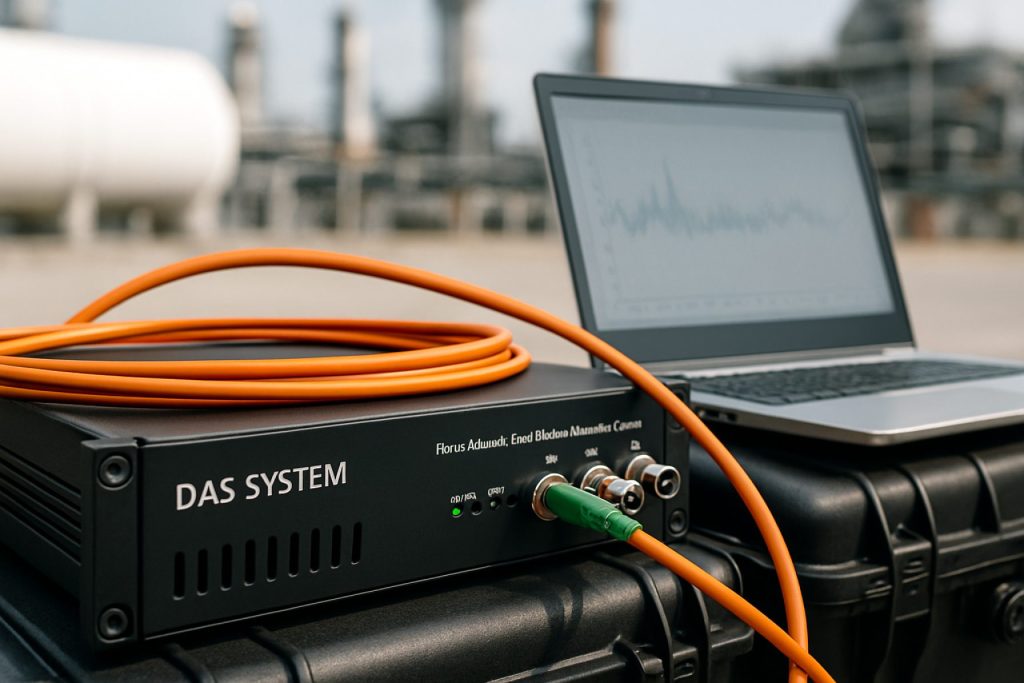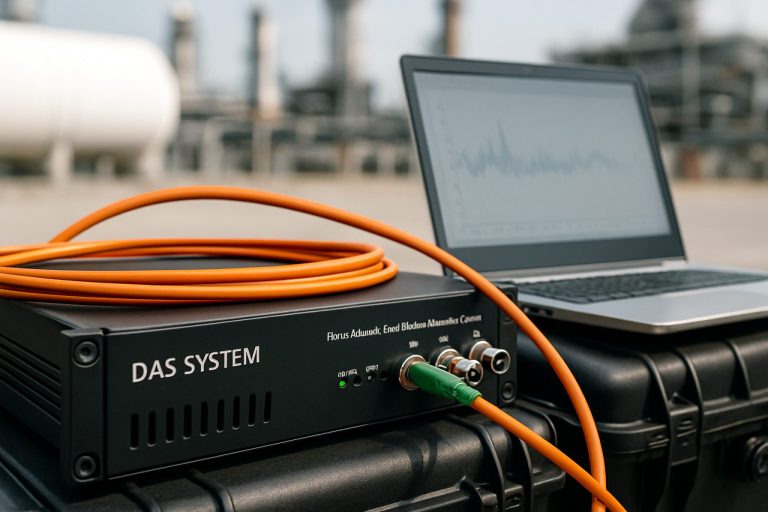
2025 Fiber-Based Distributed Acoustic Sensing Systems Market Report: In-Depth Analysis of Growth Drivers, Technology Innovations, and Global Opportunities Through 2030
- Executive Summary & Market Overview
- Key Technology Trends in Fiber-Based Distributed Acoustic Sensing Systems
- Competitive Landscape and Leading Players
- Market Growth Forecasts (2025–2030): CAGR, Revenue, and Volume Analysis
- Regional Market Analysis: North America, Europe, Asia-Pacific, and Rest of World
- Future Outlook: Emerging Applications and Investment Hotspots
- Challenges, Risks, and Strategic Opportunities
- Sources & References
Executive Summary & Market Overview
Fiber-based distributed acoustic sensing (DAS) systems represent a transformative technology in the field of real-time, continuous monitoring across various industries. These systems utilize standard optical fibers as distributed sensors, detecting acoustic signals and vibrations along the entire length of the fiber. This capability enables applications in pipeline monitoring, perimeter security, railway track integrity, and seismic activity detection, among others. The global market for fiber-based DAS systems is poised for robust growth in 2025, driven by increasing demand for advanced monitoring solutions, heightened security concerns, and the expansion of critical infrastructure.
According to recent market analyses, the fiber-based DAS market is expected to reach a valuation of approximately USD 1.2 billion by 2025, growing at a compound annual growth rate (CAGR) of over 10% from 2022 to 2025. This growth is underpinned by the technology’s ability to provide real-time, high-resolution data over long distances, often exceeding 50 kilometers per sensing channel, without the need for additional power sources along the fiber route. The oil and gas sector remains the largest adopter, leveraging DAS for leak detection, intrusion monitoring, and asset integrity management. However, rapid adoption is also observed in transportation, power and utilities, and defense sectors, as organizations seek to enhance operational safety and efficiency MarketsandMarkets.
Geographically, North America and Europe are leading the market, attributed to early technology adoption, stringent regulatory frameworks, and significant investments in infrastructure security. The Asia-Pacific region is anticipated to witness the fastest growth, fueled by expanding energy infrastructure and increased focus on smart city initiatives Fortune Business Insights. Key industry players, including Halliburton, Huawei, and Luna Innovations, are investing in R&D to enhance system sensitivity, reduce false alarms, and enable integration with advanced analytics platforms.
In summary, the fiber-based distributed acoustic sensing systems market in 2025 is characterized by technological innovation, expanding application scope, and increasing end-user awareness. The convergence of digital transformation trends and the need for resilient, real-time monitoring solutions will continue to propel market growth, positioning DAS as a critical component in the future of infrastructure management and security.
Key Technology Trends in Fiber-Based Distributed Acoustic Sensing Systems
Fiber-based Distributed Acoustic Sensing (DAS) systems are rapidly evolving, driven by advancements in photonics, data analytics, and integration with digital infrastructure. In 2025, several key technology trends are shaping the landscape of DAS, enhancing their performance, scalability, and application scope across industries such as energy, transportation, and security.
- Enhanced Spatial Resolution and Sensing Range: Recent innovations in laser sources and optical interrogators have significantly improved the spatial resolution and sensing range of DAS systems. Modern systems can now detect and localize acoustic events with sub-meter accuracy over distances exceeding 100 kilometers, enabling more granular monitoring of pipelines, railways, and perimeters. These improvements are supported by research and product developments from companies like Halliburton and Silixa.
- Integration with Artificial Intelligence and Machine Learning: The adoption of AI and ML algorithms is transforming DAS data interpretation. Advanced analytics platforms can now automatically classify and filter acoustic signals, distinguishing between benign and critical events in real time. This reduces false positives and enhances operational efficiency, as highlighted in recent deployments by Baker Hughes and Huawei.
- Cloud-Based Data Management and Edge Computing: The exponential growth in data generated by DAS systems has led to the adoption of cloud-based storage and edge computing solutions. These technologies enable real-time data processing, remote monitoring, and seamless integration with enterprise asset management systems. Schlumberger and Microsoft have been at the forefront of offering cloud-enabled DAS solutions.
- Multi-Parameter Sensing and System Integration: There is a growing trend toward integrating DAS with other distributed fiber optic sensing modalities, such as Distributed Temperature Sensing (DTS) and Distributed Strain Sensing (DSS). This multi-parameter approach provides a comprehensive view of asset health and environmental conditions, as demonstrated in projects by OptaSense.
- Miniaturization and Cost Reduction: Advances in photonic integration and manufacturing have led to more compact and cost-effective DAS interrogators. This trend is making DAS technology accessible to a broader range of applications, including urban infrastructure monitoring and smart city deployments, as noted by Fotech Solutions.
These technology trends are expected to accelerate the adoption of fiber-based DAS systems in 2025, driving innovation and expanding their role in critical infrastructure monitoring and security.
Competitive Landscape and Leading Players
The competitive landscape for fiber-based distributed acoustic sensing (DAS) systems in 2025 is characterized by a mix of established fiber optics companies, specialized sensing technology firms, and emerging startups. The market is driven by increasing demand for real-time monitoring solutions across industries such as oil & gas, power & utilities, transportation, and security. Key players are focusing on technological innovation, strategic partnerships, and global expansion to strengthen their market positions.
Leading players in the fiber-based DAS market include Halliburton, Schneider Electric, Honeywell International Inc., and Luna Innovations Incorporated. These companies leverage their extensive R&D capabilities and established customer bases to deliver advanced DAS solutions tailored for harsh and complex environments. For instance, Luna Innovations has expanded its product portfolio with high-sensitivity DAS systems for pipeline monitoring and perimeter security, while Halliburton continues to integrate DAS into its digital oilfield services.
Specialized firms such as Fotech Solutions (a bp Launchpad company) and OptaSense (a QinetiQ company) are recognized for their proprietary DAS technologies and strong presence in the energy and infrastructure sectors. Fotech Solutions has made significant strides in urban infrastructure monitoring, while OptaSense is noted for its global deployments in pipeline and border security applications.
The market also features innovative entrants such as Hifi Engineering and AP Sensing, which are gaining traction through targeted solutions and flexible business models. AP Sensing has expanded its reach in the power cable monitoring segment, leveraging its distributed fiber optic sensing expertise.
- Strategic collaborations and mergers are shaping the competitive dynamics, as seen in QinetiQ’s acquisition of OptaSense and bp’s investment in Fotech.
- Product differentiation is increasingly based on system sensitivity, data analytics integration, and ease of deployment.
- Regional expansion, particularly in Asia-Pacific and the Middle East, is a key focus for market leaders seeking to tap into infrastructure and energy sector growth.
Overall, the 2025 fiber-based DAS market is marked by intense competition, rapid technological advancements, and a clear trend toward integrated, data-driven monitoring solutions.
Market Growth Forecasts (2025–2030): CAGR, Revenue, and Volume Analysis
The global market for fiber-based distributed acoustic sensing (DAS) systems is poised for robust growth between 2025 and 2030, driven by expanding applications in oil & gas, security, infrastructure monitoring, and power & utility sectors. According to projections from MarketsandMarkets, the distributed acoustic sensing market is expected to achieve a compound annual growth rate (CAGR) of approximately 8.5% during this period. Revenue is forecasted to rise from an estimated $1.2 billion in 2025 to nearly $2.0 billion by 2030, reflecting increasing adoption across both developed and emerging economies.
Volume analysis indicates a parallel surge in the deployment of fiber-based DAS units, with annual installations projected to exceed 15,000 units by 2030, up from around 8,500 units in 2025. This growth is underpinned by the technology’s ability to provide real-time, long-range monitoring with high spatial resolution, which is particularly valued in pipeline integrity management, perimeter security, and smart infrastructure projects.
Regionally, North America and Europe are anticipated to maintain their dominance in market share, owing to ongoing investments in energy infrastructure and stringent regulatory requirements for asset monitoring. However, the Asia-Pacific region is expected to register the fastest CAGR, propelled by rapid industrialization, urbanization, and the expansion of smart city initiatives, as highlighted by Fortune Business Insights.
- Oil & Gas Sector: The sector will remain the largest end-user, accounting for over 40% of total market revenue in 2025, as operators prioritize pipeline safety and leak detection.
- Infrastructure Monitoring: Adoption in railways, bridges, and tunnels is set to accelerate, with a CAGR exceeding 10% through 2030, according to IDC.
- Security & Perimeter Applications: Demand for advanced intrusion detection and border security solutions will further fuel market expansion.
Overall, the fiber-based DAS market’s growth trajectory from 2025 to 2030 will be shaped by technological advancements, cost reductions, and the increasing need for real-time, distributed sensing solutions across critical infrastructure sectors.
Regional Market Analysis: North America, Europe, Asia-Pacific, and Rest of World
The global market for fiber-based distributed acoustic sensing (DAS) systems is experiencing robust growth, with regional dynamics shaped by industry adoption, infrastructure investments, and regulatory environments. In 2025, North America, Europe, Asia-Pacific, and the Rest of the World (RoW) each present distinct opportunities and challenges for DAS deployment.
North America remains a leading market, driven by extensive oil & gas infrastructure, advanced pipeline monitoring, and increasing adoption in security and perimeter applications. The United States, in particular, benefits from significant investments in smart infrastructure and energy sector modernization. According to MarketsandMarkets, North America’s DAS market is bolstered by stringent safety regulations and the presence of major industry players, fostering innovation and early adoption of fiber-based sensing technologies.
Europe is characterized by strong regulatory frameworks supporting critical infrastructure protection and environmental monitoring. Countries such as the United Kingdom, Germany, and Norway are at the forefront, leveraging DAS for railway monitoring, border security, and renewable energy projects. The European Union’s focus on digital transformation and smart grid initiatives further accelerates market growth. IDTechEx highlights that European utilities and transportation sectors are increasingly integrating DAS to enhance operational efficiency and safety.
Asia-Pacific is the fastest-growing region, propelled by rapid urbanization, expanding energy networks, and government-led infrastructure projects. China and India are major contributors, with large-scale deployments in pipeline monitoring, seismic activity detection, and smart city applications. The region’s growth is supported by rising investments in telecommunications and the need for advanced monitoring solutions in densely populated areas. Fortune Business Insights notes that Asia-Pacific’s DAS market is expected to witness double-digit CAGR through 2025, outpacing other regions due to its scale and pace of infrastructure development.
Rest of the World (RoW) encompasses Latin America, the Middle East, and Africa, where adoption is emerging but uneven. The Middle East, with its extensive oil & gas sector, is a notable adopter, particularly for pipeline security and leak detection. Latin America and Africa are gradually embracing DAS, primarily in mining and energy applications, though market penetration is limited by budget constraints and infrastructure challenges. According to Global Market Insights, targeted investments and international partnerships are expected to drive gradual growth in these regions through 2025.
Future Outlook: Emerging Applications and Investment Hotspots
Looking ahead to 2025, fiber-based distributed acoustic sensing (DAS) systems are poised for significant expansion, driven by both technological advancements and the emergence of new application domains. The market is expected to benefit from increased investments in infrastructure monitoring, energy sector digitization, and the growing need for real-time, high-resolution sensing solutions.
One of the most promising emerging applications is in smart city infrastructure, where DAS systems are being deployed for continuous monitoring of bridges, tunnels, and railways. These systems enable early detection of structural anomalies and unauthorized activities, supporting predictive maintenance and enhancing public safety. The integration of DAS with artificial intelligence and machine learning algorithms is further improving event classification and reducing false alarms, making these solutions more attractive for municipal and government investments (International Data Corporation).
In the energy sector, particularly in oil and gas, fiber-based DAS is increasingly used for pipeline monitoring, leak detection, and perimeter security. The shift toward digital oilfields and the need for remote, real-time asset management are accelerating adoption. Additionally, the renewable energy sector—especially wind and solar farms—is beginning to leverage DAS for cable monitoring and intrusion detection, opening new investment avenues (Wood Mackenzie).
Telecommunications is another hotspot, as operators repurpose existing fiber-optic networks for distributed sensing, enabling dual-use infrastructure that supports both data transmission and environmental monitoring. This trend is expected to lower deployment costs and drive adoption in urban and suburban areas (Light Reading).
Geothermal and seismic monitoring represent emerging frontiers, with DAS systems providing dense, real-time data for earthquake detection and subsurface imaging. This is attracting research funding and commercial interest, particularly in regions prone to seismic activity (U.S. Geological Survey).
From an investment perspective, hotspots include North America and Asia-Pacific, where government initiatives and private sector partnerships are fostering rapid deployment. Venture capital and strategic investments are flowing into startups focused on advanced analytics and miniaturized DAS hardware, signaling robust growth potential for 2025 and beyond (CB Insights).
Challenges, Risks, and Strategic Opportunities
Fiber-based Distributed Acoustic Sensing (DAS) systems are gaining traction across industries such as oil & gas, security, and infrastructure monitoring due to their ability to provide real-time, continuous acoustic data over long distances. However, the market in 2025 faces a complex landscape of challenges, risks, and strategic opportunities that will shape its trajectory.
Challenges and Risks
- Technical Complexity and Integration: DAS systems require sophisticated signal processing and interpretation algorithms. Integrating these systems with existing infrastructure, especially in legacy environments, can be technically challenging and costly. The need for skilled personnel to manage and interpret DAS data further complicates adoption.
- High Initial Investment: The upfront costs for deploying fiber-based DAS, including fiber optic cable installation and advanced interrogator units, remain significant. This can deter adoption, particularly among small and medium-sized enterprises (MarketsandMarkets).
- Data Management and Cybersecurity: DAS generates vast volumes of sensitive data. Ensuring secure transmission, storage, and analysis is a growing concern, especially for critical infrastructure applications. The risk of cyberattacks targeting these data streams is increasing as digitalization accelerates (Gartner).
- Standardization and Interoperability: The lack of industry-wide standards for DAS hardware and data formats can hinder interoperability and slow market growth. This fragmentation makes it difficult for end-users to compare solutions and for vendors to scale globally.
Strategic Opportunities
- Expansion into New Verticals: Beyond oil & gas and perimeter security, DAS is finding applications in smart cities, transportation (railway and road monitoring), and environmental monitoring. These emerging use cases offer significant growth potential (IDTechEx).
- Advancements in AI and Edge Computing: Integrating artificial intelligence and edge analytics with DAS can enhance real-time event detection and reduce data transmission costs. This can make DAS more accessible and valuable to a broader range of users.
- Collaborative Ecosystems: Partnerships between DAS vendors, telecom operators, and infrastructure owners can accelerate deployment and innovation. Joint ventures and open platforms may help address standardization and interoperability challenges.
In summary, while fiber-based DAS systems face notable technical, financial, and operational hurdles in 2025, strategic innovation and cross-industry collaboration present clear pathways to market expansion and resilience.
Sources & References
- MarketsandMarkets
- Fortune Business Insights
- Halliburton
- Huawei
- Luna Innovations
- Silixa
- Baker Hughes
- Schlumberger
- Microsoft
- OptaSense
- Fotech Solutions
- Honeywell International Inc.
- bp
- IDC
- IDTechEx
- Global Market Insights
- Wood Mackenzie



